|
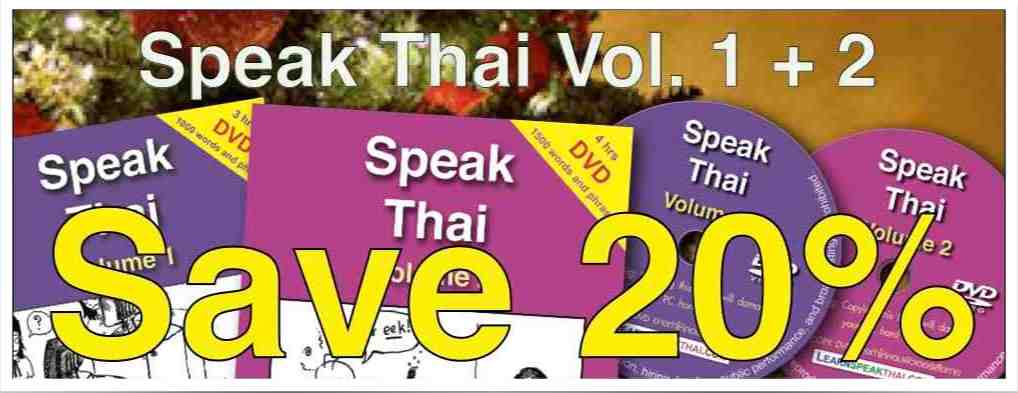 



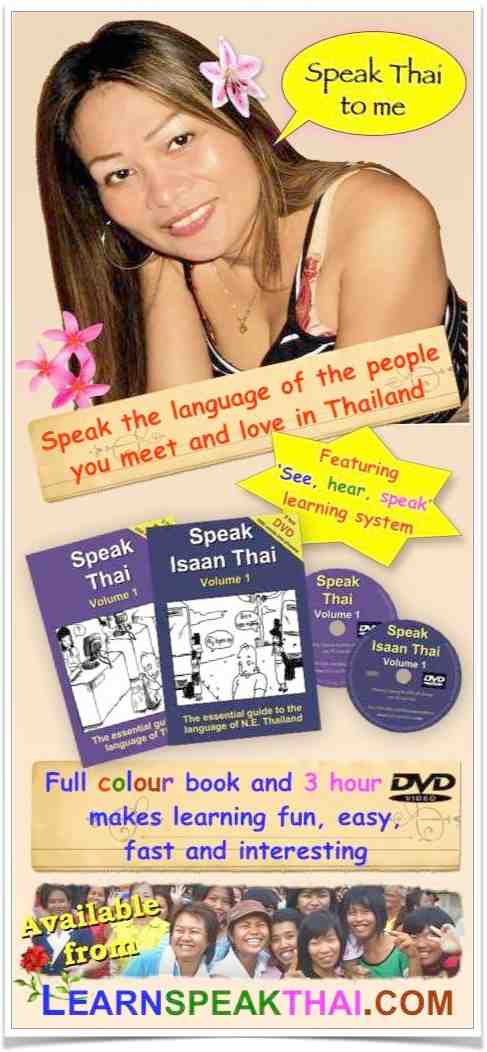
Thai - Hello
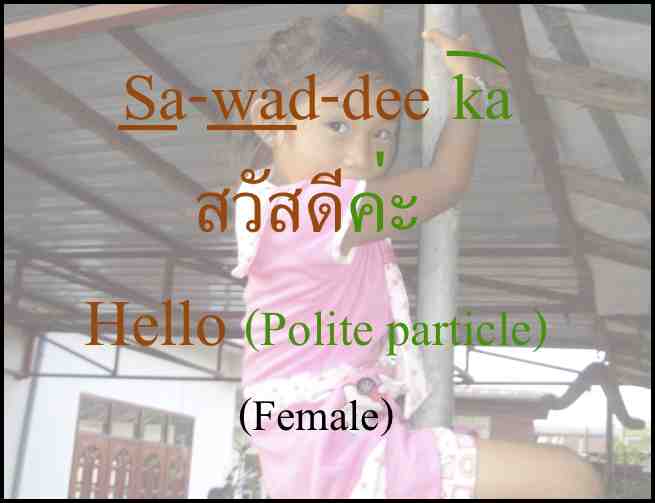
Isaan Thai - I drink beer
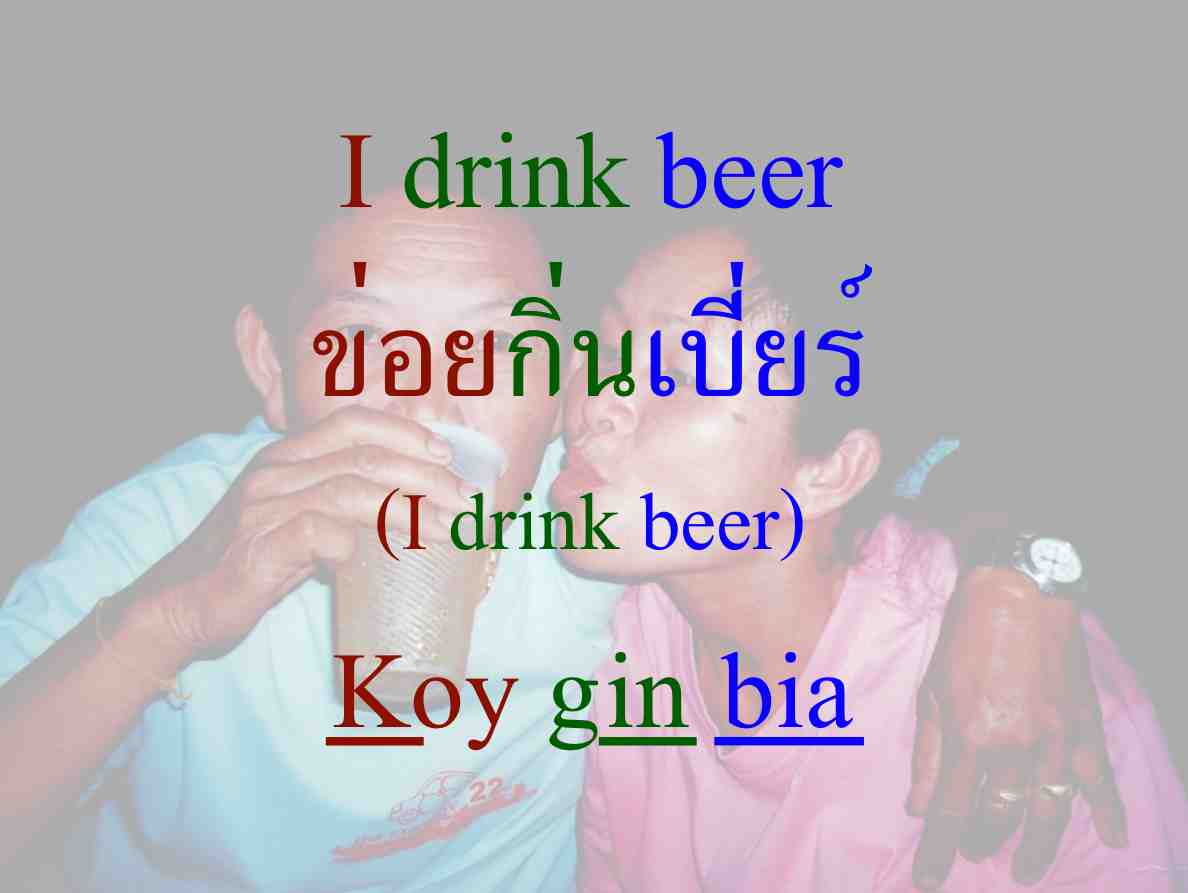
Thai - What is your name?
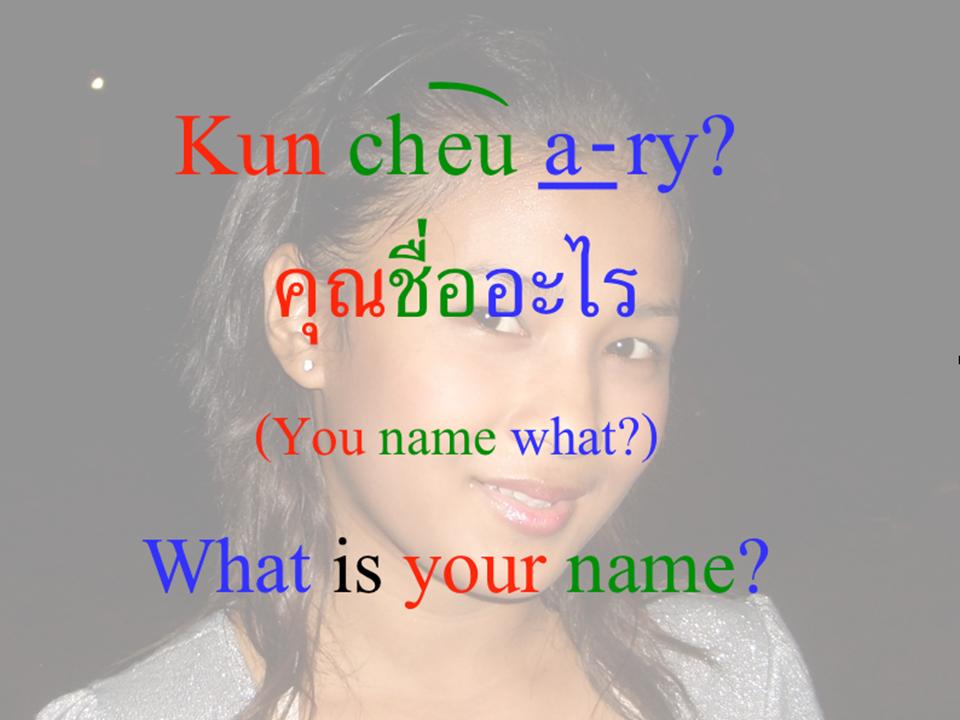
Isaan Thai - We like you
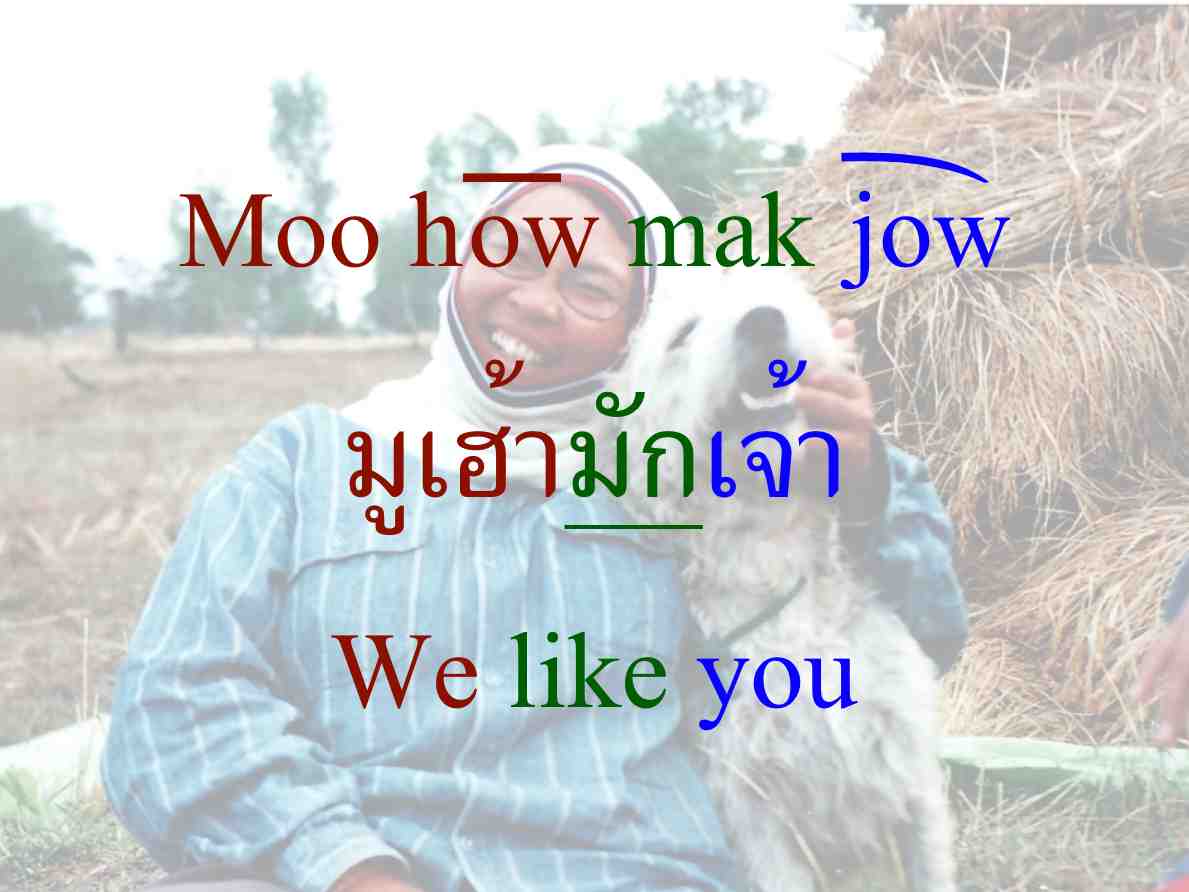
Thai - I want a beer Chang
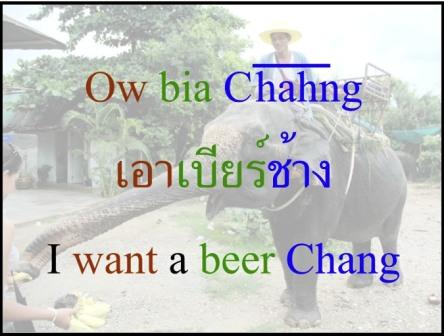
Isaan Thai - I miss you

Thai - Can we meet again?

Isaan Thai - I'll phone you tomorrow

Thai - Good luck

Isaan Thai - How are you?
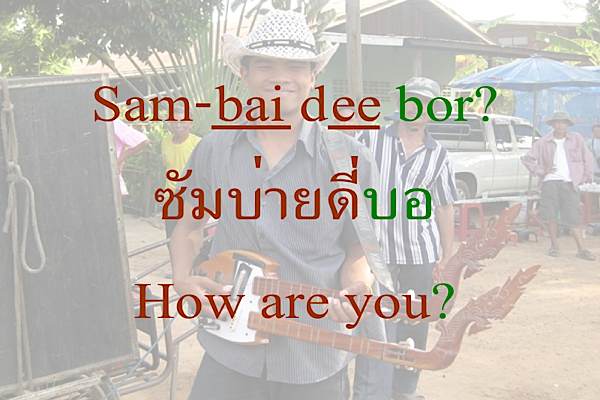
Thai - I'm just looking

Isaan Thai - Where do you come from?

Thai - Please switch on the fan

Isaan Thai - You're welcome



Speak the language of the people you meet and love in Thailand.
Start learning today!
|
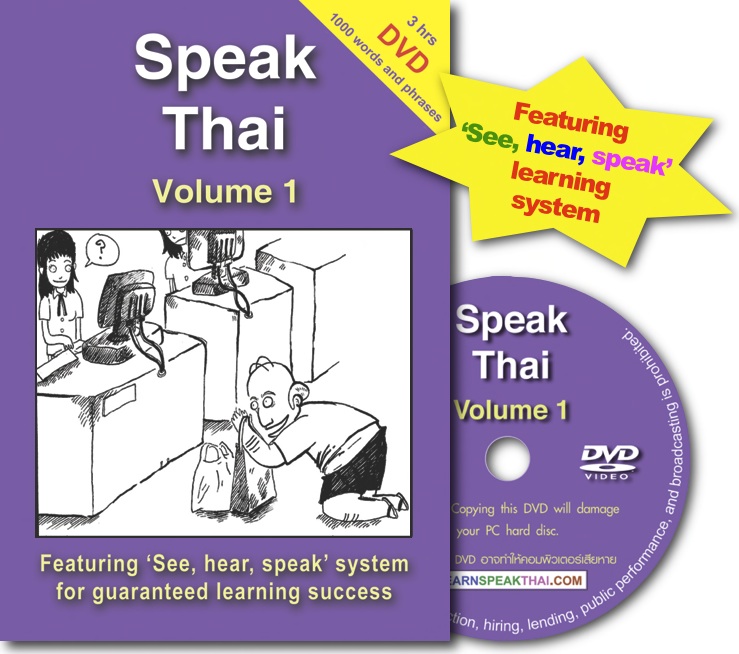
'Great. I have tried other books and this is the best by far. This book and DVD guides you step by step and is much cheaper than some online courses. I think I can start to move forward with my Thai studies. Korp kun krap.' Carl Petty, U.K.
Speak Thai Volume 1 Grammar
Speak Thai Volume 1 covers all the fundamental grammar, language and word understanding you need to know to speak Thai successfully. Aspects of grammar are introduced in either distinct segments or are explained as and when they crop up in words and phrases. Whilst the list below may look daunting, rest assured, these aspects of grammar and word use are covered in a simple, interesting and easy to understand way.
PRONUNCIATION CHAPTER
- How to pronounce the five Thai tones
- Pronouncing Thai vowels
- The importance of pronouncing short and long vowel length correctly
- Pronouncing Thai consonants
- Special focus on pronouncing difficult Thai consonants: ng, dt, bp, r
- Pronouncing Thai consonants ‘p’, ‘t’ and ‘k’ that appear at the end of words correctly
- Being aware of colloquial pronunciation of words beginning to r consonants
- Being aware of ‘r’ and ‘l’ consonants sound being dropped in consonant cluster words
- Being aware of ‘kw’ consonants sound changing to ‘f’ sound
- Being aware of tone irregularities between how a word is written in Thai script and the tone they are actually spoken
GREETINGS
- Structure of language: Word order is subject - verb - object
- Structure of language: Adjectives follow object / noun they relate to
- Structure of language: Verb doesn’t change its form for I. you, he / she, we, they
- Structure of language: Singular and plural nouns and adjectives don’t change their form
- Structure of language: Verb remains the same for tenses
- Structure of language: Connecting words like the, is, are, and, to, a, am etc. are omitted
- Personal pronouns: I / me (male), I / me (female), you, he / she, we / us, They, It
- Personal pronouns: Use of ‘ter’ to express he / she
- Personal pronouns: Use of ‘puak’ with pronouns
- Personal pronouns: Use / non use of word for ‘it’
- Personal pronouns: Omitting pronouns when context is clear
- Personal pronouns: Noun + pronoun + verb sentence forms: using peoples names
- Personal pronouns: Noun + pronoun + verb sentence forms: using animal and object names
- Polite particles: Polite particles: ‘krap’ / ‘ka’
- Polite particles: Using ‘krap’ / ‘ka’ to show politeness
- Polite particles: Using ‘krap’ / ‘ka’ to indicate you are showing attention and agreement
- Polite particles: Using ‘krap’ / ‘ka’ to indicate yes
- Polite particles: ‘krap pom’
- Saying hello: Formal and informal ‘sa-wad-dee krap / ka’ greeting
- Use of word ‘len’ with verbs to indicate an action is being done for fun
- Use of word ‘nah’ / ‘nah kaow’ to indicate field / rice field / farm
- Verb compounds: Using of 2 verbs together without any linking words
- ‘Bpy ... mah’: Meaning and usage
- How Thai words are formed: Literal word meanings for compound words
- Origin and use of ‘nang’ (leather) in words
- Colloquial way of saying hospital
- Use of English words in Thai: End consonant ‘l’ becomes an ‘n’
- Explanation of Thai word for shopping
- Making conversation: ways to be proactive
- Making conversation: Use of ‘laeo kun la’
- Explanation of ‘you, you’ greeting
- Suggested response to ‘you, you’ greeting
- The ‘gin kaow’ greeting
- Reduplication: practice of repeating certain verbs
- ‘My’: Use of question marker word ‘my’ at end of sentence
- ‘My’: Use of ‘my’ at beginning of sentence
- ‘My aroy’: Explanation of strength of criticism this implies
- Use of ‘welcome’ in greeting
- Explanation of ‘how are you?’ greeting and appropriate form of response
- The ‘fa-rang, fa-rang’ greeting: meaning and suggested response
- ‘Lah gorn’ goodbye: word meaning ‘gorn’
- Use of polite particle ‘na’ in conjunction with ‘krap’ / ‘ka’
- ‘Chohk dee’: Meaning and use as a goodbye greeting
- Meeting words ‘pop’, ‘jer’, ‘bra-chum’: what to use and when
- Use of hello word ‘sa-wad-dee’ for goodbye
MEETING PEOPLE
- Thai - the compound word language: How Thai words are formed
- Thai - the compound word language: Examples of verb + verb, verb + noun, noun + noun
- Question words: The role of questions in your Thai conversations
- Question words: Question marker (my?), what?, where?, when?, why?, which?, who?, how?, how much? / how many?, How long? (time)
- Responding positively to questions asked using ‘my?’: Repeating the verb
- Responding negatively to questions asked using ‘my?’: Saying ‘my’ before the verb
- Using high and low tone ‘na’ polite particles
- Explanation of word ‘yoo’ and use / non use with ‘tee’
- Idiosyncratic use of ‘bpy ary?’ and ‘bpy tam ary?’ to ask ‘where?’
- Use of ‘tam-my?’ (why?) at beginning and end of sentences
- Idiosyncratic use of ‘a-ry’ to mean ‘which?’
- Use of present, past, and future tense markers in sentences: ‘gamlang’ / ‘yoo’, ‘laeo’, ‘ja’
- Use of surnames in Thailand
- Use of polite title ‘kun’
- Use of forename with title ‘kun’, ‘mr.’, ‘mrs.’
- Thai ‘nicknames: their importance and meaning
- Examples of common Thai nicknames and meaning
- To be: use of ‘bpen’ and ‘yoo’
- Using ‘bpen kon’ to indicate nationality
- When to use ‘bpra-teht’ or ‘meuang’ to indicate country
- Explanation of cultural pleasantry of asking how old you are: age in Thai society
- Thai numbers: Use of ‘sip’
- Thai numbers: Use of ‘et’ to indicate ‘one’
- Age: Use of ‘kuap’ and ‘bpee’ when asking a persons age
- Age: Use of ‘laeo’
- Use of ‘nak’, ‘kon’ and ‘chahng’ with occupational titles
- ‘Chy my?’: Asking to confirm something you believe to be correct
- ‘Krap’ / ‘ka’: Importance of use when speaking Thai
EATING
- Request words: ‘kor’, ‘ow’, ‘chuay’, ‘dy my?’, ‘chern’
- Use of particle ‘noy’ with ‘kor’ for added politeness: ‘kor … noy’
- ‘Chuay’: Meaning when ‘duay’ is added
- ‘Chern’: Meaning of word ‘chern’ when used with a verb and when used on its own
- Use of word ‘kor-tort krap / ‘kor-tort ka’
- Polite particles: ‘noy’, ‘na’, ‘la’(high and low tone)
- Using ‘na’ with commands
- Using ‘na’ with statements
- Using ‘na’ with requests, friendly warnings and when telling people things directly
- Using ‘la’ with ‘krap’ / ‘ka’
- Explanation of word meanings of ‘neua’
- Explanation of word meanings for ‘noo’
- Drink: ‘deum’ / ‘nam deum’ meaning and usage
- ‘Laeo reu yang?’: Explanation of question form and how to respond
- ‘Laeo reu yang?’: How shortened in everyday speech
- ‘Dy my?’: Response forms to ‘dy my?’ questions
- ‘Bpen my?’: Responding to ‘bpen my?’ questions
- ‘My dy’: How meaning changes when used after verb and before verb
- ‘My dy’: Examples of use to mean can’t, and use to mean ‘didn’t
- Expected responses to the ‘Is it tasty?’ question
- Use of word ‘nit noy’ to indicate a little bit
- Use of word ‘eek’ as more or again
- Using the phrase ‘im laeo’ to reject offer of food
- Use of ‘gern bpy’, ‘mahk’, ‘nit noy’, ‘my mahk’, ‘my’, to indicate a degree of a characteristic
- Words you can use to soften a negative response
- Use of ‘tow-ry’ at the end of a sentence
- Superlatives: Using ‘tee sut’
- Intensifying a thank you
- Use of reduplication in a thank you
DRINKING
- Want words and how to use them: ‘yahk’ / ‘yahk ja’
- Want words and how to use them: ‘ow’
- Want words and how to use them: ‘dtorng gahn’
- To like: ‘chorp’
- To bring: ‘ow…mah’
- To take: ‘ow .. .bpy’
- Words that can be used for to mean ‘for’: ‘hy’, ‘sam-rap’
- Word meanings for ‘low kaow’ and ‘see sip’
- Explanation of word ‘mee’: To have or there is
- Use of ‘reu’ (or) without question marker
- Words that can mean with: ‘sy’, ‘gap’, ‘duay gan’
- Word meaning and use of ‘hew’ and ‘hew nam’
- How to respond to open and closed question forms
- Words used to offer a toast
- Use of bottle and bag classifier words when ordering beer and ice
- Meaning of ‘hy’ as ‘for me’ when pronoun is omitted when asking for assistance
- The concept of ‘sa-nuk’ and expressing that something is fun
- Thai values of politeness (su-pahp) and consideration for others (grehng jy)
- Use of ‘soop bu-ree’ and ‘soop’ in relation to smoking
TALKING ABOUT LANGUAGE, FAMILY AND PEOPLE
- Question tags: ‘chy my?’
- Question tags: ‘laeo ler yang?’
- Question tags: ‘reu bplow?’
- Question tags: ‘rer?’
- Question tags: ‘rer?’ spoken as ‘ler?’
- Question tags: Using combinations of question tags and questions together – ‘my chy, rer?’ / ‘a-ry rer?’
- Language: Using ‘ork’ (out) with verb to indicate an action has not been brought to a conclusion
- Language: Use of compliments in Thai society – ‘poot Ty geng’
- Language: Suitable responses to being told that you ‘poot Ty geng’
- Language: Use of ‘dtae’ (but)
- Language: Use of ‘rork’ to contradict a statement or opinion
- Language: Use of ‘kor hy’ (request for me) in requests
- Language: Interjections and their use
- Family: Use of ‘sah-mee’ and ‘pua’ when referring to husband
- Family: Use of ‘pan-ra-yah’ and ‘mia’ when referring to wife
- Family: Use of ‘look’ and ‘dek’ when referring to children
- Family: Use of grandmother term as title of respect for older people
- Family: Use of family kinship terms in place of pronouns: ‘pee’, ‘norng’
- Family: Use of kinship terms when being introduced to other to indicate status in family hierarchy
- Family: Meaning of word ‘faen’
- Family: ‘Mia noy’ (little wife) and her place in Thai society
- Family: Explanation of word for step mother (mae liang)
- Family: ‘Korng’: meaning, use and omitting
- Family: Use of ‘dtae’ to add perspective
- Family: Reminder of use of ‘kuap’ and ‘bpee’ when asking age
- Family: Use of classifier ‘kon’ when asking about siblings
- Family: Explanation of use of sniff kiss to express endearment
- People: Use of ‘bpen’ and ‘kon’ when attributing a personality characteristic to someone
- People: Explanation of word ‘bpum bpooi’
- People: Use of ‘nah gliat’ (ugly) to describe both physical looks and objectionable actions
- Grammar: The use of pre-fixes to modify word meanings
- Grammar: Use of pre-fix ‘nah’
- Grammar: Use of pre-fix ‘gahn’
- Grammar: Use of pre-fix ‘kwahm’
- Grammar: Use of pre-fix ‘kee’
- Vocabulary building: Opposite words
TRANSLITERATION GUIDE
- Phonetic transliteration: Low class consonants
- Phonetic transliteration: Mid class consonants
- Phonetic transliteration: High class consonants
- Phonetic transliteration: Short vowels
- Phonetic transliteration: Long vowels
For Speak Thai Vol. 1 content:
Speak Thai Volume 1 Content
Speak Thai Volume 1 Learn Speak Thai Home
|






















